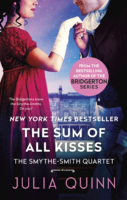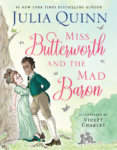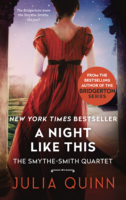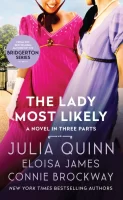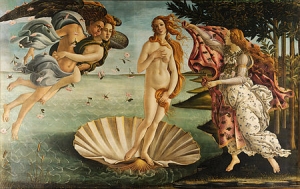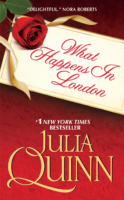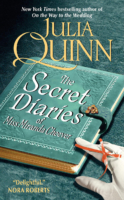Inside the Story
There is always more to the story — the story of writing the book, that is. For each book I gather a few interesting tidbits, sometimes some images, even a few videos. These appear on each book page, but I've also gathered them all here, too.
Inside The Sum of All Kisses
- The Patch of Green (where Daniel and Hugh fight their duel) is not a real location. I really wasn’t sure where the men would be most likely to duel, but I wanted it to sound as if there was an infamous spot everyone knew about.
- At the outset of Chapter Two, Sarah and Honoria are talking about Gareth St. Clair, whom some of you might recognize as the hero of It’s in His Kiss. This particular scene takes place several years before Gareth meets and falls in love with Hyacinth, so he is still a single (and very eligible) gentleman at the time of Sarah and Honoria’s conversation.
- Eloisa James fans will recognize the Duke of Kinross and Lady Edith Gilchrist, who are guests at Marcus and Honoria’s wedding. Although neither protagonist from Once Upon a Tower actually appears “on screen” in The Sum of All Kisses, both are mentioned, and Iris’s frantic search for Edie leads to some rather significant self-reflection on the part of Sarah.
- Once again, I was unable to resist the lure of Miss Butterworth and the Mad Baron. My favorite novel-within-a-novel makes its fifth appearance in my books in The Sum of All Kisses. It made its debut in It’s in His Kiss as one of the books Hyacinth reads to Lady Danbury, then it became a big part of the plots of both What Happens in London and Ten Things I Love About You. I managed to work it into Just Like Heaven, as well. And now it’s a graphic novel!
- Oranges and Lemons is an old English nursery rhyme that developed into a singing game similar to (but not exactly like) “London Bridge is Falling Down.” The lyrics refer to the bells of churches located in or near the City of London. Perhaps the most famous of these churches is St. Sepulchre-Without-Newgate, which is referred to in the rhyme as “the bells of Old Bailey” due to its location opposite London’s Central Criminal Court, commonly known as “Old Bailey.” The bells of St. Sepulchre tolled whenever a condemned man was marched from nearby Newgate Prison to the gallows for his execution. Additionally, St. Sepulchre’s bellman was responsible for ringing the a large handbell known as the Executioner’s Bell inside Newgate at midnight on the day of an execution. Today, the Executioner’s Bell resides in a glass case in St. Sepulchre’s.
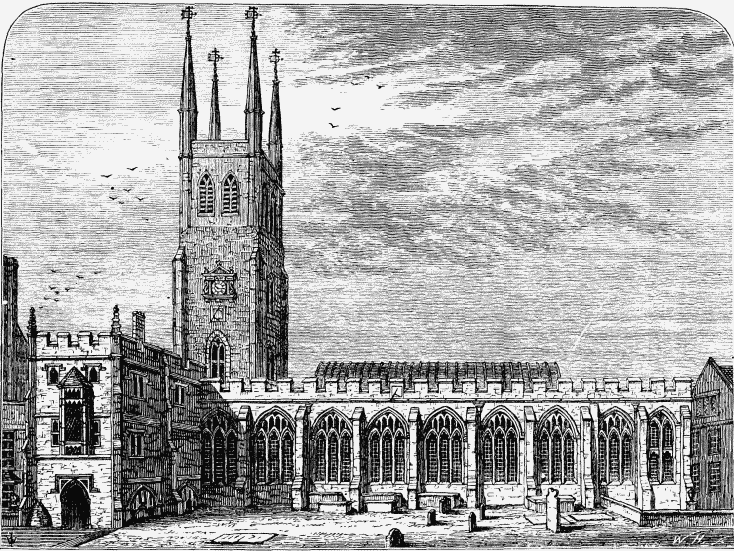
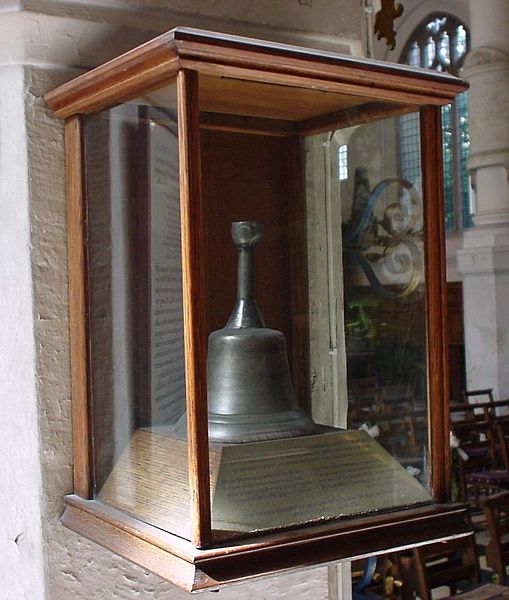
- Oil of Sweet Vitriol is an old-fashioned word for diethyl ether, more commonly known simply as ether. Ether is one of the oldest known anesthetics; it was first synthesized in 1540 by Valerius Cordus.
- The wealthy usually had their newspapers ironed before they read them. This was not to eliminate wrinkles but rather to seal the ink so that it did not rub off on people’s hands.
Inside The Bridgertons: Happily Ever After
- Over the years I have found that the best way to keep my writing “fresh” is to change how I write (since I don’t want to change what I write). The Bridgerton 2nd Epilogues provided the perfect outlet for this. The shorter format was a breath of fresh air, and I even wrote one in the first person.
- I have always felt that I could not write a full-length novel about Violet and Edmund Bridgerton, despite countless request from readers. I thought (and still think) it would be too difficult, knowing that he would die so young. But I wanted to show a bit of their courtship, and the episodic nature of Violet in Bloom gave me the perfect opportunity to do this.
- I almost wrote the bonus story about a Bridgerton descendent (instead of about Violet.) I must confess to a wild curiosity about what those Bridgertons were doing during World War II.
- I am often asked to name my favorite of my novels. It’s an impossible question; each of my books has something about it I adore. But I will confess that the 2nd Epilogue When He Was Wicked might be my #1.
- If a scene isn’t working, I usually figure that out before getting too far, which is why I don’t have very many deleted scenes posted on my website. “Violet in Bloom,” however, turned out to the an exception, and I wrote a fifteen-page scene that did not make it into the final book. You can read it exclusively here on juliaquinn.com.
Inside The Lady Most Willing…
- I loved the Duke of Bretton’s dry sense of humor in The Lady Most Likely…, so when Eloisa, Connie, and I decided to work on a second collaboration together, I quickly claimed him as my hero, even though The Lady Most Willing… is not in any way a sequel to The Lady Most Likely….
- I am not much of an expert on medieval castles, so I will admit that I assumed that people made butter in the buttery. It’s actually a service room for storing beer and other alcoholic drinks. The name comes from the medieval French word botte, which comes from the Latin buttis, or “barrel.” Incidentally, the word “bottle,” derives from the French bouteille, which in turn comes from my favorite Latin word ever: butticula.
- It turns out I also didn’t know very much about the traditional Highland sport of caber tossing. It turns out that the win does not go to the man who throws the caber the farthest, but rather the one who comes closest to landing the large log in the most vertical position.

Note from TeamJQ: We cannot find the provenance of this caber tossing photo. Please contact us if it is yours so we can properly credit.
Inside A Night Like This
- Harriet Pleinsworth first made her first appearance in It’s in His Kiss when Hyacinth and Gareth discovered that what they thought was to be a poetry reading had been changed to a performance of an original composition—The Shepherdess, the Unicorn, and Henry VIII. Written, of course, by Harriet Pleinsworth. It’s in His Kiss takes place one year after A Night Like This, so I had a lot of fun setting up the pieces of Harriet’s future “masterwork.”
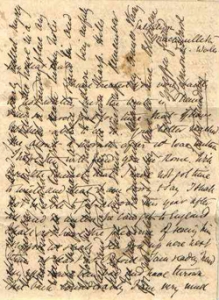
- I have always been fascinated by postal systems and had great fun researching how Anne might send letters to her sister. At the time of A Night Like This, postage was paid by the recipient of a letter, not the sender. Since postage was calculated in part by the number of sheets in the letter, many people economized by writing “crossed” letters. After filling a sheet with words, the writer would turn the paper ninety degrees and start again. It looks difficult to read to me, but I’m told that it’s not so bad once you get the hang of it. Members of Parliament (including peers sitting in the House of Lords) were able to send letters without charge. This was called “franking,” or using their “free frank.” All they had to do was sign their name on the front of the letter. As you can probably imagine, the privilege of the free frank was widely abused.
- You wouldn’t think it would be nearly impossible to include a reference to a Shakespearean play, but I had a fiendishly difficult time figuring out the proper way to mention Henry VI, Part II. That’s what I had in my manuscript, but my copyeditor changed it to Henry VI, Part 2. This crazy half-italicized version looked completely wrong to me so I went online and the very first reference I found was: Henry VI, Part 2. In my agony, I asked my husband what he thought. He very wisely grabbed our copy of The Complete Works of Shakespeare, and we found The Second Part of Henry VI. And as if that weren’t enough, I stumbled on an academic website that listed it as 2 Henry VI. At this point, I did what I should have done in the first place. I emailed Eloisa James, whose day job happens to be Brilliant Shakespeare Professor. She informed me that academics do refer to the play as 2 Henry VI and that she thought that in conversation people would have said The Second Part of Henry VI. Is anyone dizzy yet? I decided to eliminate the problem and change it to Macbeth. But then guess what happened? My proofreader noticed that I had forgotten to change an earlier reference to the play and I was scolded for calling Macbeth a history instead of a tragedy. I ended up changing it back to Henry VI, Part II. Which is what I had in the first place.
- All of the inns mentioned at the end of the book are real inns in Hampstead. The Spaniards Inn (where much of the action takes place) is one of the oldest inns in London and has quite a storied history. Dick Turpin, the famed highwayman, was apparently born there, and Charles Dickens mentioned it in The Pickwick Papers. I don’t believe you can stay at the inn any longer, but the restaurant and garden are very popular.
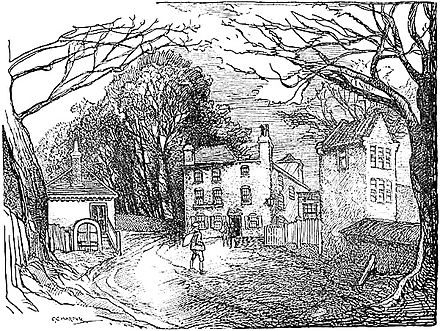
“The Spaniards,Hampstead Heath”. from The Old Inns of Old England, Volume I (of 2), by Charles G. Harper page 323. Illustration by author. Published in London in 1906 by CHAPMAN & HALL, Limited. Public domain image.
Inside Just Like Heaven
- Writing Just Like Heaven took a lot of research. Not of history or of music, but rather of my own novels. I had included Smythe-Smith characters in so many books that I had to take several days just to compile all of my previous mentions. Once I did that, I had to decide which set of Smythe-Smith cousins I was going to write about. I discovered that I had written about musicales taking place in 1816, 1819, 1824, and 1825. I settled on the girls from 1824/1825, in part because I wanted to be able to spread the quartet of books over two seasons.
- Families and family relationships are very important in my writing, so when I develop characters for a book I have to understand their family structure. This meant I had to figure out how many brothers and sisters each character had and where they were in the birth order. Because the Smythe-Smiths are such a large family, I had to come up with eight separate nuclear families. To do this I had to recreate nineteen years of Smythe-Smith quartets. Yes, you read that right. Nineteen years of them! If for some reason I ever need to know who played the viola in 1815, I’ve got the info at my fingertips. (Literally, since I do have to type to pull up my computer files.)
- I desc
 ribed Honoria’s preferred shade of pink as “primrose.” Imagine my horror when I read that the lovely yellow dress Queen Elizabeth wore to the Duke and Duchess of Cambridge’s wedding is being described as “primrose yellow.” I maintain that primroses come in many hues. (P.S. I thought the Queen looked lovely. Mrs. Middleton, too.)
ribed Honoria’s preferred shade of pink as “primrose.” Imagine my horror when I read that the lovely yellow dress Queen Elizabeth wore to the Duke and Duchess of Cambridge’s wedding is being described as “primrose yellow.” I maintain that primroses come in many hues. (P.S. I thought the Queen looked lovely. Mrs. Middleton, too.) - My husband is a physician, specializing in infectious diseases, so naturally I asked him to look over the scene when Marcus is so ill. After I read it to him, he paused for a moment, then said, “He has to die.” I said, “Perhaps you don’t understand how this works.” In the end, I modified the scene to make Marcus’s wound a bit less infected.
- I’m actually not that crazy about the name Honoria and probably would not have used it for a heroine except that I had already mentioned her in a Lady Whistledown column in Romancing Mr. Bridgerton. There was no way I could resist a scene in which Lady Danbury destroys a violin!
- Miss Butterworth and the Mad Baron rides again! My favorite novel-within-a-novel first appeared in It’s in His Kiss, then came back in What Happens in London and Ten Things I Love About You. And now my sister Violet Charles and I have adapted it as a graphic novel!
- All of the books Honoria brings Marcus during his convalescence are real. Except Butterworth, of course.
- Mozart’s Piano Quartet, No. 1 is indeed thought to be an extremely difficult piece and the Smythe-Smiths absolutely should not have attempted it. Then again, Mozart also wrote “Twinkle Twinkle Little Star,” and they probably should not attempt that, either.
Inside The Lady Most Likely…
- When Eloisa James, Connie Brockway, and I decided that we were going to collaborate on a novel in three parts, we knew that we would need to get together to plot the book and develop the characters. So we took a fabulous long weekend to New Orleans—we got a ton of work done (and gained about six pounds—each!)
- The original title for The Lady Most Likely… was The List. Eventually we decided that even though it fit the book very well, it wasn’t very interesting, so we changed it.
- Alec’s name was originally Marcus. I changed it because I realized that I’m running out of good hero names. Since I already had an Alex (in Splendid), I figured I was unlikely to use Alec for a full-length novel. I ended up using Marcus as the hero’s name in Just Like Heaven.
- Gwendolyn is often compared to Botticelli’s Venus in his seminal painting The Birth of Venus.
- Gwendolyn’s mother makes up an impromptu song called, “A House Party La La La.” This was inspired by “A Weekend in the Country,” from the Stephen Sondheim musical A Little Night Music.
- Eloisa James named the local village Parsley, so naturally I had to name the inn The Sage and Thyme. There is no mention of an innkeeper, but I am sure his wife is named Rosemary.
- I loved the Duke of Bretton’s dry sense of humor so much in The Lady Most Likely… that when we decided to team up again for The Lady Most Willing…, I quickly claimed him as my hero. He is the only connection between the two collaborations, though.
Inside Ten Things I Love About You
- Sebastian first appeared in What Happens in London. He kind of stole the show, so it was pretty clear to me he’d need his own book. And in fact, I’ve given him another book: the graphic novel adaptation of Miss Butterworth and the Mad Baron!
- Sebastian and Annabel meet at Lady Trowbridge’s party in Hampstead–the same party at which Daphne and Simon share their first kiss in The Duke and I. (Not the same year, though; I’ve decided Lady Trowbridge’s party is an annual event.)
- In What Happens in London, Harry Valentine had to leave The Magic Flute after the first act, and Olivia had to miss the performance entirely, so I was happy to give them an opportunity to finally see the opera.
- I have often been asked if I plan to write a paranormal romance. The answer is no, but I will confess to pride and amusement at my having managed to use the word, “undead” in this novel.
- Lady Twombley is the former Cressida Cowper, who appeared as the “mean girl” in The Viscount Who Loved Me and Romancing Mr. Bridgerton.
- At the Hartside Ball, Annabel dances with a veritable compendium of characters from my previous books: Nigel Berbrooke (from The Duke and I), Mr. Albansdale (who married Felicity Featherington), Neville Berbrooke (from On the Way to the Wedding), Mr. Cavender (the villain in An Offer from a Gentleman), Prince Alexei (from What Happens in London), Sir Harry Valentine (the hero from What Happens in London), and Gareth St. Clair (the hero from It’s in His Kiss). Except for Harry, none of these men have anything to do with the plot of Ten Things I Love About You. But I needed to list the men Annabel danced with, and I thought I might as well use characters we’d seen before.
- I can’t skip stones. I’ve always wished that I could.
- In the epilogue, Sebastian says that if he takes Annabel’s advice he will “go down in a flaming pit of ruin.” I said the exact same thing to my husband, for the exact same reason.
- Any Spinal Tap fans out there? This book goes to eleven.
Inside What Happens in London
- Although What Happens in London is a companion book to The Secret Diaries of Miss Miranda Cheever, TSDOMMC’s hero and heroine don’t make an appearance. I had originally intended them to, but they didn’t end up fitting in the plot.
- I’m not so sure I would have made my prince Russian if I’d realized how difficult the language is to translate. Because Russian uses the Cyrillic alphabet, it needs to be both translated and transliterated. I worked with five different Russian speakers to help me translate the text, and they never agreed on the best way to do it. In the interest of consistency, I ended up going with the translations as done by my copyeditor, whom I’m told has a Masters in Russian literature.
- Miss Butterworth and the Mad Baron first appeared in It’s in His Kiss as one of the books Hyacinth was reading to Lady Danbury. I had no plans to use it again, but when I needed Harry to give Olivia an unusual gift, it just popped into my mind. I LOVED writing the passages in this book. It is seriously fun to write bad literature. So much fun, in fact, that my sister Violet Charles and I turned it into a graphic novel!
- In regency times, the wealthy had their butlers iron their newspapers before they read them. This was not to eliminate wrinkles but rather to seal the ink so that it did not rub off on people’s hands.
- “Hell’s Vengeance Boileth in Mine Heart” is the most famous aria from Mozart’s The Magic Flute, and is more commonly referred to as the Queen of the Night’s Aria. It is known for its difficulty, reaching a high F6, which is rare in opera.
Famed soprano Diana Damrau sings the Queen of the Night aria.
Inside The Lost Duke of Wyndham
- For years I’ve wanted to write a two-book set based on the premise: “Two men say they’re the Duke of Something. One of them must be wrong.” (Two points if you can guess where that line comes from. Or you can just peek at my this interview I gave.)
- The Lost Duke of Wyndham and Mr. Cavendish, I Presume take place concurrently, and their plots are very closely intertwined. When I began to develop these two novels, it became clear that if I didn’t want the plot or characters of one book to be dependent upon the other, I would need to write the two books simultaneously. Many scenes occur in both books, but from different points of view.
- The working title of this book was The Two Dukes of Wyndham. In the end, that became the name of the two-book set.
- The model who portrays Grace on the cover is actually the actress Ewa Da Cruz, who plays Vienna Hyatt on As the World Turns. I’d originally written Grace with brown eyes, but when I saw the cover, I changed them to blue!
- This portrait of Marie-Louise O’Murphy by Francois Boucher is the painting that so captured Grace’s imagination:
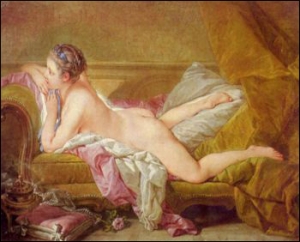
- When I wrote The Lost Duke of Wyndham, I purposefully made no mentions of characters from previous books. After eight Bridgerton books, I think I was eager to create an entirely new fictional world. But then, many years later I realized I had (subconsciously?) sneaked in one reference. The Dowager Duchess’s maiden name is Debenham, and twice in When He Was Wicked, the characters refer to that “awful Debenham side” of Michael’s family. Which fits pretty well with the dowager, don’t you thinnk?
Inside The Secret Diaries of Miss Miranda Cheever
- Version 1.0 of The Secret Diaries of Miss Miranda Cheever was written in 1994, just after Splendid (my first novel) was bought for publication. For various reasons, it never quite made it onto the publishing schedule, but I always thought it was the best of my early books, so I kept waiting for the right moment to finally publish it. With the Bridgerton series complete, 2007 seemed the perfect time. I’d planned to spend 2-3 weeks cleaning it up, but I quickly realized I’d need 2-3 months. I found the process enormously exciting and enriching—it was the first time in years I was free to just write, without having to worry about what was going to happen next.
- I resisted the temptation to drop a Bridgerton into the story, but I did keep the mention of the Duke of Ashbourne, who was the hero of Splendid. I’d included him back in the first version and saw no reason to change him.
- Most of the book is a blend of what was written in 1994 and 2006, but some large chunks and scenes come from just one version. The prologue is almost entirely from 1994, while Chapter One is completely new. The scene in the bookshop is also almost entirely from the early version.
- Miranda lives in the Lake District, in the village of Ambleside, which in the 19th century was in the county of Cumberland. In 1974, however, the UK enacted the Local Government Act 1972, which reorganized many administrative counties. Cumberland was absorbed into Cumbria (along with Westmorland and parts of Lancashire and the West Riding of Yorkshire) and was wiped off the administrative map. The name still exists as a geographical and cultural term, however. But it’s a warning to historical romance writers everywhere—make sure you look at maps from the time period in which you are writing! It would have been terrible if I’d had Miranda living in Cumbria.
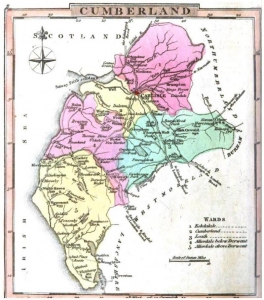
1824 map of Cumberland. Public domain as per Wikimedia Commons

